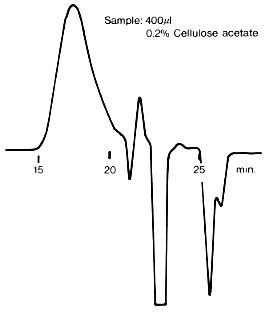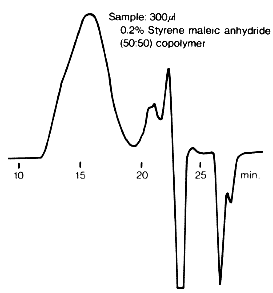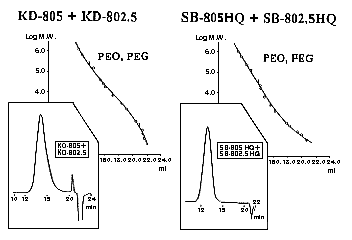Hydrophobic Polymers: DMF Eluent
Analysis using KD-800 columns
Poly(ethylene oxide) standards were analyzed using GPC KD-802 and KD-806M (columns for organic SEC (GPC)).

Sample :
1. PEO, Poly(ethylene oxide) (MW: 1,200,000)
2. PEO, Poly(ethylene oxide) (MW: 100,000)
3. PEO, Poly(ethylene oxide) (MW: 10,000)
4. PEO, Poly(ethylene oxide) (MW: 2,000)
5. PEO, Poly(ethylene oxide) (MW: 600)
6. EG, Ethylene glycol (MW: 62)
Columns : Shodex GPC KD-806M + KD-802 (8.0mmID*300mm each) Eluent : 0.01M LiBr in DMF Flow rate : 1.0mL/min Detector : Shodex RI Column temp. : 50deg-C
Poly(ethylene glycol) standards were analyzed using GPC KD-802 + KD-801 (columns for organic SEC (GPC)).

Sample :
1. PEG, Poly(ethylene glycol) (MW: 20,000)
2. PEG, Poly(ethylene glycol) (MW: 2,000)
3. PEG, Poly(ethylene glycol) (MW: 600)
4. PEG, Poly(ethylene glycol) (MW: 200)
5. EG, Ethylene glycol (MW: 62)
Columns : Shodex GPC KD-802 + KD-801 (8.0mmID*300mm each) Eluent : 0.01M LiBr in DMF Flow rate : 1.0mL/min Detector : Shodex RI Column temp. : 50deg-C
Polystyrene standards were analyzed using GPC KD-802 (a column for organic SEC (GPC)).

Sample :
1. PS, Polystyrene (MW: 37,000)
2. PS, Polystyrene (MW: 4,000)
3. PS, Polystyrene (MW: 580)
Columns : Shodex GPC KD-802 (8.0mmID*300mm) x 2 Eluent : 0.01M LiBr in DMF Flow rate : 1.0mL/min Detector : Shodex RI Column temp. : 50deg-C
Phenol resin was analyzed using GPC KD-803 + KD-802 (columns for organic SEC (GPC)).

Sample : Phenol resin, resol type
Columns : Shodex GPC KD-803 + KD-802 (8.0mmID*300mm each) Eluent : 0.01M LiBr in DMF Flow rate : 1.0mL/min Detector : Shodex RI Column temp. : 50deg-C
Phenoxy resin was analyzed using GPC KD-806M (a column for organic SEC (GPC)).

Sample : Phenoxy resin
Columns : Shodex GPC KD-806M (8.0mmID*300mm) x 2 Eluent : 0.01M LiBr in DMF Flow rate : 1.0mL/min Detector : Shodex RI Column temp. : 50deg-C
Melamine resin was analyzed using GPC KD-802 (a column for organic SEC (GPC)).

Sample : Melamine resin
Columns : Shodex GPC KD-802 (8.0mmID*300mm) x 2 Eluent : 0.01M LiBr in DMF Flow rate : 1.0mL/min Detector : Shodex RI Column temp. : 50deg-C
Poly(vinylpyrrolidone) was analyzed using GPC KD-806M (a column for organic SEC (GPC)).

Sample :
(A) 0.2% PVP, Poly(vinylpyrrolidone) (K 30) 400micro-L
(B) 0.2% PVP, Poly(vinylpyrrolidone) (K 60) 500micro-L
(C) 0.2% PVP, Poly(vinylpyrrolidone) (K 90) 500micro-L
Columns : Shodex GPC KD-806M (8.0mmID*300mm) x 2 Eluent : 0.01M LiBr in DMF Flow rate : 1.0mL/min Detector : Shodex RI Column temp. : 50deg-C
In the case of polymers which have ionic functional groups, the ionic functional groups repel each other and/or aggregation take place, and therefore, the apparent molecular size of the polymers become large. When analyzing such polymers by a organic SEC (GPC) column (GPC KD-806M) with DMF as the eluent, elution time may be very fast and/or abnormal peak shape may be obtained. To prevent such ionic dissociation, the addition of salts such as LiBr is know to be effective. Although the optimal concentration of LiBr is considered to be around 10mM, no systematic study on this point has been performed. Here, the result of the study to determine the optimal concentration range of LiBr in DMF is shown for polyvinylpyrrolidone. It is confirmed that the concentration of 10mM which has been used traditionaly is in the range of optimal concentration range. In the figure, chromatograms show the output from RI detector and “x” marks show the output from MALS (multi angle laser light scattering) detector. The table shows the calculation result from the data of MALS detector. As you can see from the table and figure, larger molecular weight and larger molecular size components are mesured when the LiBr concentration is 0 to 0.001mM compared with the case when the LiBr concentration is 0.5 to 50mM. From the result, we can say that apparent large molecular weight components exist because of ion repellent within the polymer, electrostatic with column packing material and aggregation of the polymers when LiBr concentration is not enough.
Please refer to the case of cellulose acetate.

| LiBr conc. | Mw(x104) | Mn(x104) | Rw(nm) | Rz(nm) |
|---|---|---|---|---|
|
0mM
|
(750)
|
(297)
|
(222)
|
(371)
|
|
0.001mM
|
(220)
|
(132)
|
(243)
|
(259)
|
|
0.01mM
|
95.6
|
54.1
|
67.3
|
92.0
|
|
0.1mM
|
78.2
|
36.2
|
48.9
|
58.9
|
|
0.5mM
|
78.5
|
32.5
|
48.3
|
56.7
|
|
1mM
|
79.0
|
25.5
|
40.0
|
56.8
|
|
10mM
|
79.2
|
29.2
|
44.7
|
56.8
|
|
50mM
|
78.9
|
23.4
|
37.2
|
56.8
|
Sample : 0.01% PVP, Poly(vinylpyrrolidone), 100micro-L
Column : Shodex GPC KD-806M (8.0mmID*300mm) Eluent : LiBr in DMF Flow rate : 1.0mL/min Detector : Shodex RI, MALS Column temp. : 40deg-C
Poly(vinylidene fluoride) was analyzed using GPC KD-806M (a column for organic SEC (GPC)).

Sample : Poly(vinylidene fluoride)
Columns : Shodex GPC KD-G (4.6mmID*10mm) + KD-806M (8.0mmID*300mm) x 2 Eluent : 0.01M LiBr in DMF Flow rate : 1.0mL/min Detector : Shodex RI (Polarity:-) Column temp. : 50deg-C
Cellulose acetate was analyzed using GPC KD-806M (a column for organic SEC (GPC)).

Sample : Cellulose acetate
Columns : Shodex GPC KD-806M (8.0mmID*300mm) x 2 Eluent : 0.01M LiBr in DMF Flow rate : 1.0mL/min Detector : Shodex RI Column temp. : 50deg-C
In the case of polymers which have ionic functional groups, the ionic functional groups repel each other and/or aggregation take place, and therefore, the apparent molecular size of the polymers become large. When analyzing such polymers by a organic SEC (GPC) column (GPC KD-806M) with DMF as the eluent, elution time may be very fast and/or abnormal peak shape may be obtained. To prevent such ionic dissociation, the addition of salts such as LiBr is know to be effective. Although the optimal concentration of LiBr is considered to be around 10mM, no systematic study on this point has been performed. Here, the result of the study to determine the optimal concentration range of LiBr in DMF is shown for cellulose acetate. It is confirmed that the concentration of 10mM which has been used traditionaly is in the range of optimal concentration range. In the figure, chromatograms show the output from RI detector and “x” marks show the output from MALS (multi angle laser light scattering) detector.
From the result, we can say that apparent large molecular weight components exist when LiBr is not added.
Please refer to the case of Poly(vinylpyrrolidone).

Sample : 0.1% Cellulose acetate, 100micro-L
Column : Shodex GPC KD-806M (8.0mmID*300mm) Eluent : LiBr in DMF Flow rate : 1.0mL/min Detector : Shodex RI, MALS Column temp. : 40deg-C
Chlorinated rubber was analyzed using GPC KD-806M (a column for organic SEC (GPC)).

Sample : Chlorinated rubber
Columns : Shodex GPC KD-806M (8.0mmiD*300mm) x 2 Eluent : 0.01M LiBr in DMF Flow rate : 1.0mL/min Detector : Shodex RI Column temp. : 50deg-C
Styrene allylalcohol copolymer was analyzed using GPC KD-803 + KD-802 (columns for organic SEC (GPC)).

Sample : Styrene allylalcohol copolymer
Columns : Shodex GPC KD-803 + KD-802 (8.0mmID*300mm each) Eluent : 0.01M LiBr in DMF Flow rate : 1.0mL/min Detector : Shodex RI Column temp. : 50deg-C
Styrene allylalcohol copolymer were analyzed using GPC KF-606M, a downsized organic SEC (GPC) Column.

Sample : Styrene allylalcohol copolymer
Columns : Shodex GPC KF-606M (6.0mmID*150) x 2 Eluent : 0.01M LiBr in DMF Flow rate : 0.5mL/min Detector : Shodex RI(small cell volume) Column temp. : 40deg-C
Styrene maleic anhydride copolymer was analyzed using GPC KD-806M (a column for organic SEC (GPC)).

Sample : Styrene maleic anhydride (50:50) copolymer
Columns : Shodex GPC KD-806M (8.0mmID*300mm) x 2 Eluent : 0.01M LiBr in DMF Flow rate : 1.0mL/min Detector : Shodex RI Column temp. : 50deg-C
Styrene acrylonitrile copolymer was analyzed using GPC KD-806M (a column for organic SEC (GPC)).

Sample : Styrene acrylonitrile (30:70) copolymer
Columns : Shodex GPC KD-806M (8.0mmID*300mm) x 2 Eluent : 0.01M LiBr in DMF Flow rate : 1.0mL/min Detector : Shodex RI Column temp. : 50deg-C
N-Vinylpyrrolidone vinyl acetate copolymer was analyzed using GPC KD-806M (a column for organic SEC (GPC)).

Sample :
N-Vinylpyrrolidone vinyl acetate (60:40) copolymer
Columns : Shodex GPC KD-806M (8.0mmID*300mm) x 2 Eluent : 0.01M LiBr in DMF Flow rate : 1.0mL/min Detector : Shodex RI Column temp. : 50deg-C
Vinyl chloride vinyl acetate copolymer was analyzed using GPC KD-806M (a column fororganic SEC (GPC)).

Sample : Vinyl chloride vinyl acetate (90:10) copolymer
Columns : Shodex GPC KD-806M (8.0mmID*300mm) x 2 Eluent : 0.01M LiBr in DMF Flow rate : 1.0mL/min Detector : Shodex RI Column temp. : 50deg-C
Vinylidene chloride acrylonitrile copolymer was analyzed using GPC KD-806M (a column for organic SEC (GPC)).

Sample : Vinylidene chloride acrylonitrile (80:20) copolymer
Columns : Shodex GPC KD-806M (8.0mmID*300mm) x 2 Eluent : 0.01M LiBr in DMF Flow rate : 1.0mL/min Detector : Shodex RI Column temp. : 50deg-C
Comparison of SB-800 HQ columns and KD-800 columns
Polymers, whose polarity is lower than that of DMF are adsorbed by the packing materials of the GPC KD-800 columns. For such polymers, the use of the OHpak SB-800 HQ columns is recommended because their packing material has a weaker hydrophobic interaction than that of the KD-800 columns. Generally, in DMF eluent some salts like LiBr should be added for the SEC analysis of polymers having ionic groups. Salt is added to prevent ionic interaction between sample and packing material.

Sample : Poly(-N,N-dimethyl aminomethyl styrene)
Columns : Shodex GPC KD-804 +KD-802.5, OHpak SB-805 HQ + SB-802.5 HQ (8.0mmID*300mm each) Eluent : 5mM LiBr in DMF Flow rate : 1.0mL/min Detector : Shodex RI Column temp. : 40deg-C
Polymers, whose polarity is higher than that of DMF, are adsorbed by the packing materials of the OHpak SB-800 HQ columns. For such polymers, the use of the GPC KD-800 columns is recommended. On the other hand, for polymers having a lower polarity than that of DMF, the use of the SB-800 HQ columns is recommended.

Sample : Ethylene maleic anhydride copolymer
Columns : Shodex GPC KD-804 + KD-802.4, OHpak SB-805 HQ + SB-802.5 HQ (8.0mmID*300mm each) Eluent : 5mM LiBr in DMF Flow rate : 0.5mL/min Detector : Shodex RI Column temp. : 25deg-C
Vinylidene chloride acrylonitrile copolymer was analyzed. Compared with the GPC KD-800 columns, the OHpak SB-800 HQ columns perform better over a molecular weight range.

Sample : Vinylidene chloride acrylonitrile copolymer
Columns : Shodex GPC KD-805 + KD-802.5, OHpak SB-805 HQ + SB-802.5 HQ (8.0mmID*300 each) Eluent : 5mM LiBr in DMF Flow rate : 1.0mL/min Detector : Shodex RI Column temp. : 40deg-C
Phenol formaldehyde resin was analyzed using OHpak SB-800 HQ columns and GPC KD-800 columns.

Sample : Phenol formaldehyde resin
Columns : Shodex GPC KD-804 + KD-802.5, OHpak SB-804 HQ + SB-802.5 HQ (8.0mmID*300mm each) Eluent : 5mM LiBr in DMF Flow rate : 0.5mL/min Detector : Shodex RI Column temp. : 40deg-C
For the analysis of polycarbonate, the use of OHpak SB-800 HQ series is recommended because sample can be adsorbed by the packing material of GPC KD-800 series.

Sample : Polycarbonate resin
Columns : Shodex OHpak SB-802.5 HQ + SB-805 HQ, GPC KD-802.5 + KD-805 (8.0mmID*300mm each) Eluent : 5mM LiBr in DMF Flow rate : 1.0mL/min Detector : Shodex RI Column temp. : 40deg-C
